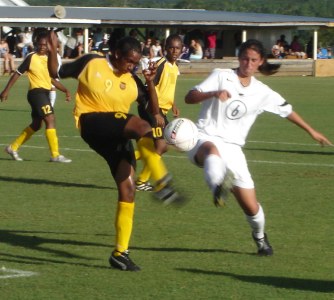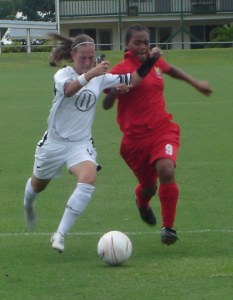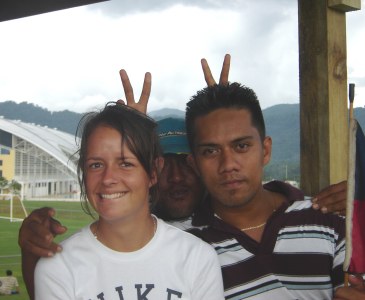The Ultimate New Zealand Soccer Website | home
Tournament Review
Tournament Review
Hail The Newly-Crowned Queens Of Oceania Soccer
by Jeremy Ruane
At the start of the 2006 Oceania Football Confederation U-20 Women's World Cup qualifying tournament, just four women present had first-hand experience of what it was like to be part of a New Zealand team which ranked as the region's best.
Carol Waller was goalkeeper of the very first NZ women's team, which won the 1975 Asian Cup. Eight years on, Ali Grant and Julie Hogg were members of the Oceania Nations Cup-winning squad, while Michele Cox was a member of the squad which qualified for the inaugural FIFA Women's World Cup Finals in 1991 as Oceania's representatives.
The ensuing fifteen years have been fairly barren ones for NZ women's soccer, with just forty-four `A' internationals having been played in that time. Playing second fiddle to Australia has also been a way of life, our West Island rivals having thwarted our attempts to repeat that 1991 qualification in 1995, 1998 and 2003, then left us to look on with envy while they have reaped the rewards which have resultingly befallen them.
But following Australia's confederation switch, there was no green-and-gold nemesis blocking New Zealand's path in Samoa, and once the final whistle sounded in Apia, the aforementioned quartet were joined by a group of lively teenage women, eighteen all told, who have realised their common dream - qualifying for a World Cup Finals, just the fourth occasion New Zealand has done so via on-field means rather than as hosts.
To a short list comprising Spain `82, China `91 and Egypt `97, you can add Russia `06 - and there's every reason to believe that China `07 will be added to this list in around twelve months' time.
For to be brutally honest, short of a catastrophe of Hillsborough Disaster proportions or an overnight collapse of the entire infrastructure of the women's game in New Zealand, an infrastructure which has been continually evolving since the code was formally established in this country in 1973, it is extremely difficult to see New Zealand being challenged as the supreme nation in Oceania women's soccer for some considerable time to come.
Yes, the island nations will improve in time, but so will New Zealand. As long as the Oceania Football Confederation exists, and the winners of OFC's women's soccer competitions continue to enjoy direct entry to FIFA's various women's world championships, the challenge facing NZ Soccer is three-pronged:
* to oversee the continued involvement of the game's infrastructure in this country, so the code here continues to grow and improve;
* to ensure our preparations for OFC qualifying tournaments are of sufficient standard and quality to maintain our position of pre-eminence as Oceania's premier women's soccer-playing nation at the conclusion of said qualifying tournaments;
* to gear our overall preparations towards achieving realistic goals at FIFA Finals.
Given our current world ranking of twenty-two, and the frequency with which the majority of nations ranked above us play in comparison to New Zealand, realistic goals at this point in time would include:
* winning a match at a FIFA Finals;
* avoiding the wooden spoon in our group.
Once NZ Soccer's plans to develop women's soccer are fully established, then such objectives as qualifying for the quarter-finals become realistic long-term targets. Once you're into the knockout stages, of course, anything can happen, and usually does.
It's as well New Zealand were in action in Apia … at least it ensured patrons of five matches in which they could witness the true potential of women's soccer when played by practitioners who have been well schooled in its rudiments, and who can both fully appreciate and employ its finer points.
For without the Kiwis, the quality of football on show was generally poor, and occasionally primitive. The
|
 Vanuatu defender Babra Lulu attempts to clear ahead of Abby Erceg
 Kirsty Yallop fends off the challenge of Tongan defender Salome Vaenuku
 NZ's Player of the Tournament, Ria Percival
 Julia Baldwin with some members of her fan club!!
 Kirsty Yallop receives the tournament trophy from OFC President, Reynald Temarii
|
bulk of the other had at least one individual who looked they had a few clues about them, but all too often, a lack of the footballing fundamentals was clearly evident among the majority of those chosen to represent the island nations in Samoa.
Indeed, the host nation was the pick of the other teams present, a fact which emphasises the strength of New Zealand's infrastructure - eight of their eighteen-strong squad reside in Auckland. They were a well-organised combination, and it was evident that their pre-tournament tour/recruiting drive in Auckland proved very beneficial to them.
Tonga also spent a couple of weeks in Auckland before the tournament, but the key to their success in getting to the final was one player - take out Penateti Feke and the Tongans would have been the footballing equivalent of a rudderless ship! They also boasted the best goalkeeper in the tournament by some distance in Siaila Laakulu.
Papua New Guinea, given their lengthy preparations which led to them being regarded as New Zealand's biggest threat pre-tournament, were rather disappointing. While striker Zeena Limbai led the line well, and scored the bulk of their goals, their most influential player was the versatile Daisy Winas, who was a real box of tricks.
The Papuans suffered more than most from injuries to key players. Indeed, all but one team suffered on the injury front, the exceptions being the team which began preparing for this tournament last October, in the National Women's League.
New Zealand was by far the most professional outfit to grace the Toleafoa JS Blatter Football Complex in Tuanaimato, Apia, throughout the ten-day tournament, and their success was due reward for a genuine all-round team effort.
Be it the coaching of John Herdman, Ali Grant and goalkeepers' mentor Jenny Bindon, the working environment and opportunities arising from the behind-the-scenes activities of Michele Cox, Graham Seatter and the NZS staff, the injury prevention programme overseen by Helen Tunstall … even the vocal backing provided by the thirty-strong supporters group of parents and friends who made the effort to witness NZ women's soccer's first success on the international stage since 1991.
It has all contributed to the overall success of a group of young women whose attitude, focused determination, work ethic, on-field performances, off-field preparations and overall sense of unity and oneness have made the dream of Russia 2006 a genuine reality.
With due praise comes a dash of criticism, however. The NZ girls were inevitably guilty of lowering their standards to the opposition's level at times, such was the lack of a genuine challenge to their superiority, which could have been emphasised by far bigger winning margins than was the case.
This was due largely to our finishing, which often lacked subtlety and finesse, and generally left a great deal to be desired at times, make no mistake. Why this seeming need to whack the casing off the ball in an effort to try and add to the holes in the net?
Had placement taken precedence over power when shooting at goal, New Zealand would have won all five games by double-figure scorelines, results which would have far more accurately reflected their dominance of the tournament.
It's one of the things the girls can continue working on, as they're still in a position to do so. For even if they'd won every match 1-0, the following eighteen players have a World Cup Finals to look forward to, having helped return New Zealand to the top of the tree in Oceania women's soccer:
Kirsty Yallop (c), Katie Hoyle (vc), Julia Baldwin, Hannah Bromley, Caitlin Campbell, Helen Collins, Ashleigh Cox, Aroon Clansey, Abby Erceg, Sarah Gregorius, Emma Harrison, Emma Humphries, Renee Leota, Annalie Longo, Ria Percival, Petria Rennie, Ali Riley, Hannah Rishworth
|